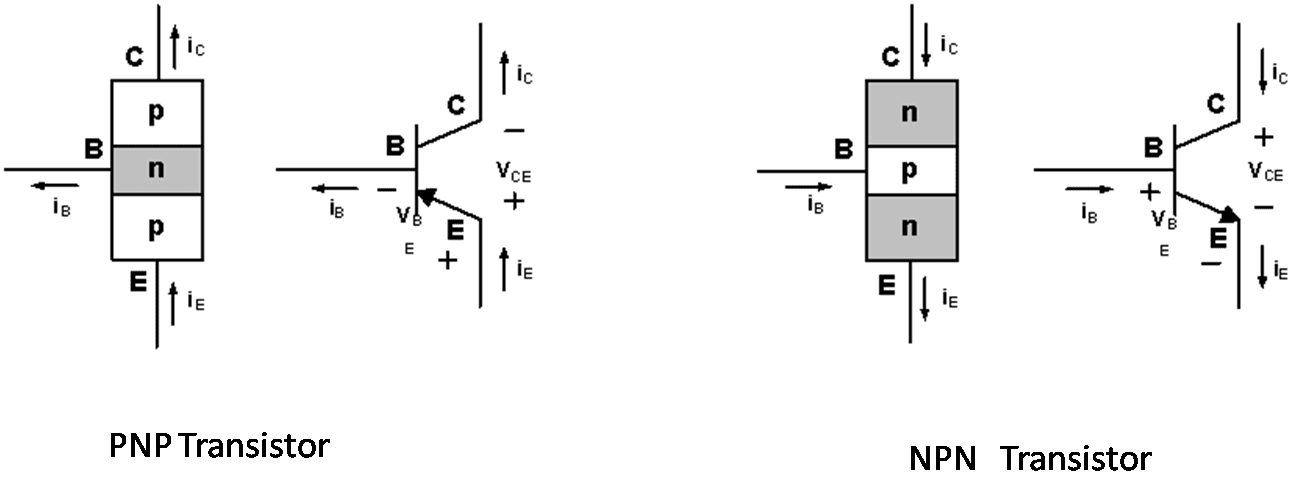Bipolar Junction Transistor (BJT) Tutorial And Notes
BIPOLAR JUNCTION TRANSISTOR
A bipolar junction Transistor or BJT or transistor is a small electronic device which can be used either as a amplifier or a switch. It consist of three layer sandwich of extrinsic semiconductor material, either a p-type is sandwich between two n-type (NPN) or a n type is sandwich between p-type(PNP). Thus three layers are formed.Each layer has a different name.They differ from each other because of there physical size and the doping levels. The side which supplies charges is called as emitter,other side which collects this charges is called as collector. The middle section is called as the base.

Lets discuss all these in detail:
EMITTER: the left region of the transistor is the emitter. Its main function is to supply majority charge carriers to the base. If transistor is NPN then electrons are majority carriers and if its PNP then holes are majority carriers. Emitter is heavily doped and forward baised wrt to base.
COLLECTOR: the right hand section is the collector and main function is to collect the majority carriers. It is always reverse baised with respect to base. It is moderately doped.
BASE: The middle region is the base.It is the thinnest of all. It is lightly doped.
There are two junction, one is the emitter and the other is the collector junction ,both have it own barrier potential. The emitter junction which is forward biased offers low resistance so that majority charge carriers can pass easily. The resistance of the collector base junction is large, thus large reverse bias is applied to the junction.
The collector region is physically large since more power is dissipated at the collector. The emitter region is a bit small and the base region is the smallest.
As seen the arrow head in the symbol is on the emitter. The direction of the arrowhead indicates the flow of current. If the direction of arrow head is from emitter to base then it is PNP transistor and if it is from base to emitter i.e. outwards then it is NPN transistor.
The transistor is a current controlled device. The output voltage power and current are controlled by the input current. Since there are two type of charge carriers: majority and minority hence it is called as Bi-Polar. In layman terms,transistor is a regulator. As the speed of the fan can be controlled manually with the help of regulator, in the same terms if electrical controlled is used to regulate the current then it is called Transistor.
Advantages of BJT
· As compared told traditional controls such as vaccum tube, it has compact size, small weight, rugged construction.
· It has medium to high voltage range. High current density.It has low voltage drop.High efficiency of operation
Applications:
· It is used as a switch.
· It can be used for Amplification.
· It is used in Oscillating Circuits.
· It is many a time used in sensors
A bipolar junction Transistor or BJT or transistor is a small electronic device which can be used either as a amplifier or a switch. It consist of three layer sandwich of extrinsic semiconductor material, either a p-type is sandwich between two n-type (NPN) or a n type is sandwich between p-type(PNP). Thus three layers are formed.Each layer has a different name.They differ from each other because of there physical size and the doping levels. The side which supplies charges is called as emitter,other side which collects this charges is called as collector. The middle section is called as the base.

Lets discuss all these in detail:
EMITTER: the left region of the transistor is the emitter. Its main function is to supply majority charge carriers to the base. If transistor is NPN then electrons are majority carriers and if its PNP then holes are majority carriers. Emitter is heavily doped and forward baised wrt to base.
COLLECTOR: the right hand section is the collector and main function is to collect the majority carriers. It is always reverse baised with respect to base. It is moderately doped.
BASE: The middle region is the base.It is the thinnest of all. It is lightly doped.
There are two junction, one is the emitter and the other is the collector junction ,both have it own barrier potential. The emitter junction which is forward biased offers low resistance so that majority charge carriers can pass easily. The resistance of the collector base junction is large, thus large reverse bias is applied to the junction.
The collector region is physically large since more power is dissipated at the collector. The emitter region is a bit small and the base region is the smallest.
As seen the arrow head in the symbol is on the emitter. The direction of the arrowhead indicates the flow of current. If the direction of arrow head is from emitter to base then it is PNP transistor and if it is from base to emitter i.e. outwards then it is NPN transistor.
The transistor is a current controlled device. The output voltage power and current are controlled by the input current. Since there are two type of charge carriers: majority and minority hence it is called as Bi-Polar. In layman terms,transistor is a regulator. As the speed of the fan can be controlled manually with the help of regulator, in the same terms if electrical controlled is used to regulate the current then it is called Transistor.
Advantages of BJT
· As compared told traditional controls such as vaccum tube, it has compact size, small weight, rugged construction.
· It has medium to high voltage range. High current density.It has low voltage drop.High efficiency of operation
Applications:
· It is used as a switch.
· It can be used for Amplification.
· It is used in Oscillating Circuits.
· It is many a time used in sensors
0
